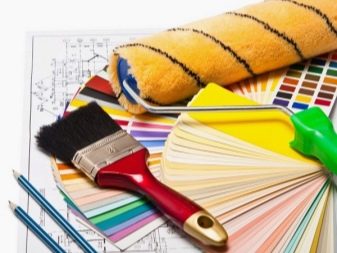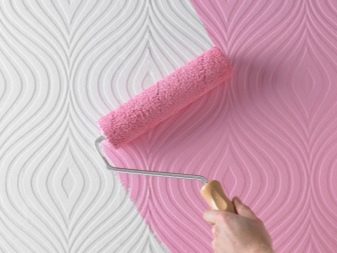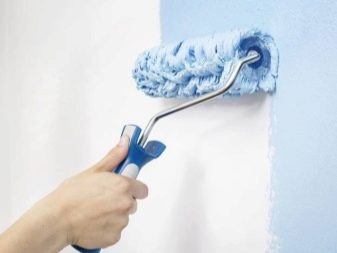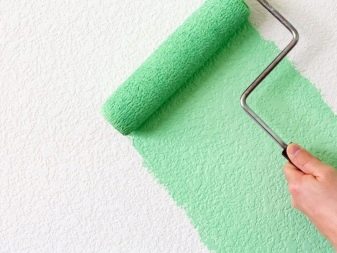Paint rollers: varieties and features of use

Repair is a long-term event that requires thorough preparation, financial and time costs, as well as the acquisition of theoretical and practical knowledge. Staining is one of the most common and effective tricks for decorating surfaces. A huge variety of colors and shades, application techniques and textures give plenty of fantasy to roam. However, behind the seeming simplicity of this finishing option, many nuances are hidden: what paint to choose, how to properly treat the surface, how to apply the color scheme so that the color lays down evenly, and annoying streaks and unpainted places do not spoil the overall look of the project and the nerves of the would-be painter.

You can use a variety of tools to paint walls, such as brushes, an airbrush, or a roller.
Roller - the golden mean between them... Has a large number of modifications and options for rollers. The paint guarantees almost perfect, the paint consumption is moderate. Ease of use, ease of maintenance and optimal cost create an ideal combination of "price and quality". In addition, with the help of this device, you can apply a decorative pattern, stencil drawing and even add texture.


Features of the device
A paint roller is a device of a simple design, consisting of a handle and a curved frame, on which paint cylinders with different surfaces are attached. The principle of its action is the absorption of various substances when the drum is immersed in them and the transfer of these compounds to the surface to be painted.
Roller advantages:
- surface processing speed;
- the quality of the work on applying the composition;
- the ability to add additional effects to the processed plane;
- reducing the amount of materials consumed;
- large lineup.


Progress does not stand still, and today you can easily find such options for this tool as a roller for painting corners or a roller with an extended handle for painting ceilings and high facades. Special attention should be paid to rollers with automatic or piston feeding of the coloring substance. This tool is ideal for large flat surfaces. It is used not only when it is necessary to apply paint, but also for other substances - adhesives, varnishing, liquid wallpaper, primer. The choice of roller modification will be almost entirely based on the characteristics of the applied fluid.
When changing the substance, it is only necessary to change the surface of the roller, and the roller is ready for use again. But here it is important to take into account that the roller coat can be made of various materials: fur, foam rubber, polyester, polyacrylic, felt, rubber, wool, nylon.

To study all the tricks when choosing a fur coat, you need to take into account the features of various types of coatings, as well as recommendations for their use.
Views
Since there are a great many types of rollers in the store, it is worth understanding the criteria for their selection.
Let's decide on the principle of the roller.
- Habitual submersible.
- With a piston paint supply system - its handle comes with a reservoir that can hold half a liter of the substance at once. The substance evenly wets the rotating surface of the roller.
- With automatic dye supply. The device pays for its high cost exclusively over a large space.It is characterized by high productivity and economy of consumables, since this device is a device with a dispenser.


There are two principles of its work:
- the substance enters through the hose when using the pump;
- the roller is located in the cavity, and already from it the working surface of the drum is wetted.
By the nature of the work, rollers are:
- for the exterior (more rigid and reinforced);
- for interior work (smaller).


The tool is distinguished by the type of roller coating:
- Fur - a universal tool for painting walls. Saves paint, applies layers evenly, paints uneven and rough surfaces well, is accurate in work (there is a minimum of splashes from it). They can be made of natural fur or synthetic analogs (polyacryl, polyamide), which also differ in the length of the villi. There is a rule: the more irregularities, the longer the pile. One "but" - the villi remain on the treated surface.
- Foam - applicable for a very limited set of paints and varnishes. Differs in the lowest cost, but short-lived, sloppy (too much splashes), poorly stains irregularities, inconvenient in large areas. It is not recommended to paint the walls with them - there are too many drips. The higher its density, the more durable the roller will be.


- Velor - used for painting, varnishing. Dense staining, however, this is a tool for professionals. Working with it is sloppy, characterized by a large amount of splashes. The consumption of substances is slightly increased due to the absorption of the roller surface. The cost is relatively low.
- Thread or rag - can be used in work with any paints, are durable, but they spray a lot of material, so you should be careful.
- Flock and others with a smooth surface - only used for smooth, well-prepared surfaces. Strong and durable, have a low cost.
Wall painting can be carried out not only by painting, but also by applying a pattern or texture with decorating devices with a pattern protruding on their surface.



The rollers are subdivided according to the height of the villi:
- High pile... Hair height 18-22 mm. Ideal for working with masonry, plastered, concrete surfaces.
- Medium pile. Hair height 11-12 mm. Used when working with plasterboard, wooden areas, as well as with concrete and plaster. Able to absorb paint well. It is possible to carry out work in a high humidity environment.
- Short pile... Hair height 5-6 mm. Used for varnishing and dyeing wood and metal surfaces. The paint is used sparingly.


It is worth choosing the right roller width. They come in three sizes.
- Short. Size - 8-10 cm, diameter - 10-15 mm. Suitable for processing small areas, hard-to-reach places.
- Average... Size - 15-20cm, diameter - up to 20-90mm. Convenient when processing floor, wall, ceiling surfaces.
- Long... Size - from 25 cm, diameter - from 80 mm. It is characterized by reinforced fasteners, improved nozzle materials. Positioned as a tool for professionals.
Rollers are distinguished by the way the roller is located on the handle. There are models with a hairpin, replaceable with a fur coat, frame shock-absorbing ones.
If in your plans there is no work on painting a huge number of square meters, the design of the roller will not play a role - you can safely take any one.

Which to choose?
If you started painting work, it is necessary to choose the right not only paints and varnishes, but also a certain type of fixtures. When choosing a roller, you should familiarize yourself with the recommendations of manufacturers and sellers about the optimality of one or another option. The best-selling rollers for interior work are foam rollers.Foam rubber is a material that is absolutely not resistant to aggressive compounds, oil and alkyd paints. The only thing it is ideal for is water-based paints and adhesives, a primer.
But for working with oil, latex paint and enamels, silicate paints and varnishes, fur rollers are perfectly adapted. The shorter the length of the villi, the smoother the surface to be treated should be.


Also, for those who are not afraid of aggressive substances, universal velor rollers are suitable. They can be used not only for water-based paints, but also for oil, alkyd, two-component paints. To apply these compositions, you can use nozzles made of synthetics, natural wool, threads with polyacrylic. To add texture, you should take a tool with a silicone coating, long nap or rubber pad.


Another important factor when choosing this tool is the quality of the fur coat: the firmware must be even, the presence of retaining rings is important. The main thing to look for when choosing a roller is the workmanship. There should be no threads sticking out of the fur coat, the stitching should be even, and there are also retaining rings. It is also worth checking for the manufacturer's markings.
Surface preparation
Preparing a surface for painting is a process that is often more time-consuming than painting itself, but it is very important. It is worth observing all the technology, without excluding any stages.
- Remove previous surface coating. Peeling loose parts of the old paint will deteriorate the overall appearance of the work and peel off the already new paint. Whitewash or water-based paint can be removed without much difficulty - moisten the surface to be treated abundantly, then go through with a spatula. Remove residues with a damp cloth. Waterproof paint is capricious, you will have to work with a metal brush to remove it.
- Next, you should wet the surface and, after waiting a little, open the windows for a draft. The coating should peel off and can be removed with a spatula. Another way: apply wallpaper glue or paste to the old paint, glue newspapers on it, and let it dry. By removing the layer of paper, you can remove the previous coating along with it. The third method is removal with a drill, but then a huge layer of dust on the surface cannot be avoided.



- Putty the surface if necessary. When removing the top layer, you can assess the condition of the base of the working surface, check for cracks, voids and irregularities that should be covered with putty.
- Sand all irregularities well with sandpaper. There is a nuance with the oil-glue putty - it discolors the water-based paint.
- Prime with starting and finishing primer. For work in a residential area, you can only use an alkyd, acrylic and mineral primer, other compounds are prohibited. The alkyd mixture is absolutely contraindicated for plasterboard and plaster surfaces.
- Clean the surface from traces of dust, dirt, grease stains. The simplest method is washing with a water-soap composition without abrasives. Plastered surfaces are checked for the possibility of chalking - if chalk marks are visible when holding the hand, it is worth re-treating this area with a universal primer.
Surface preparation work must be carried out carefully in order for the paint to lay down more efficiently and evenly.


Dyeing
- The procedure for carrying out painting work is established. First of all, the ceiling is painted, then the walls and floor.
- Masking tape marks the boundaries of the painting.
- When painting the ceiling, you should start by applying a border about 5 centimeters in size without going over to the wall. If there are ceiling cornices, then they are painted second. When painting walls, the border is applied in the corners, near windows and doors. A section of the surface from one of these places is painted over vertically with a width of one meter.Then, overlapping it, paint the adjacent area. You need to apply paint in the direction of the light.

To eliminate streaks and streaks, you need to follow the basic rules for painting with a roller.
- Do not immerse the roller completely in a container with paint. To evenly place the paint on the roller, you need to use a special corrugated pallet by rolling a roller over it. This will reduce material consumption.
- They paint without pressure, smoothly, repeating the strokes already passed, from top to bottom, but diagonally.
- Work slowly and smoothly to avoid unnecessary splashing.
An ideal surface contains several layers of paint, each subsequent one is applied only after the area has absorbed the previous layer, and it is completely dry. As soon as the roller loses its uniformity, it is replaced.


Instrument care
As with any instrument, rollers need proper care, otherwise they will become disposable and cannot be used in the future. After working with water-soluble substances and paints, you just need to rinse the roller coat with water, insert the handle and wash it with a damp cloth. If the work was carried out with more aggressive liquids, the roller should be soaked in kerosene or solvent and then washed with soapy water. The foam rollers can be thrown away. For drying, the rollers are suspended from the frame or placed vertically on the handle. To avoid creasing the fur coats, they are removed to a warm room.


In the next video you will see a demonstration of roller painting using the "W" technique.







The comment was sent successfully.